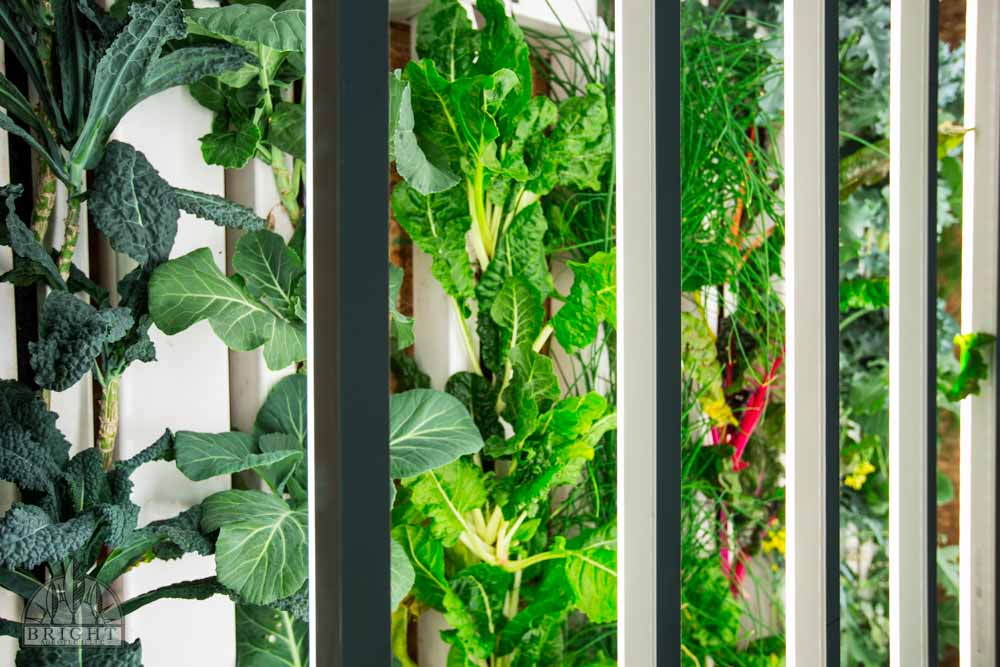Enough light ≠ optimal light
If you’re growing indoors (and maybe even if you’re growing outdoors), you should consider artificial lighting.
“Woah, hang on a second,” you’re thinking. “I have plenty of good sunlight. I don’t need more.”
While natural light might be enough for your crops to grow, you could be missing out on a lot of extra growth. Artificial lighting can increase yield significantly even when used as a supplement. It can also give you more control over quality and structure of your crops.
To decide whether or not an increase in production and quality is worth the cost artificial lighting, you need to understand about how light moves and is used in your vertical farm.
There are three variations to light dynamics and vertical farming that matter:
1) Light quality: wavelength matters to photosynthetic pigments and light penetration
First of all, there are different types of light. Different wavelengths are comprised of photons with different energy, and the pigments in plants can only use certain wavelengths.
As a quick review: the electromagnetic spectrum is based on different wavelengths of electromagnetic radiation (measured in nanometers to meters), and that visible light (measured in nanometers, “nm”) only makes up a small part of the spectrum. (About 400-700 nm.)
Different plant pigments absorb different wavelengths and use the energy for photosynthesis and
other crucial processes
Most plant pigments use wavelengths between 400-700 nm, where most visible light occurs. Some of these wavelengths are especially fit to be absorbed by a different pigment involved in photosynthesis. The three main pigments that you deal with are:
- chlorophyll a (absorbs PAR best around 430 and 660 nm),
- chlorophyll b (absorbs PAR best around 450 and 640 nm),
- and carotenoids (ß-carotene absorbs best at 450-470 and 640 nm).
Of course, not all crops have the same ratios of these pigments. And since many artificial lights are adjustable to give off certain wavelengths, you can often tailor artificial lighting to give a specific crop exactly what it needs.
Plants naturally compete for light – but you can change that
This is important to creating efficient light use.
In a natural ecology, plants compete for light use in a variety of ways. Some plant have adapted to grow taller. Others grow over their competition and choke them out. More subtle species have adapted to use the “scrap” wavelengths that do make it through the canopy to the forest floor.
This competition is unnecessary in your vertical farm. You’re the boss of your greenhouse, and you want all plants to use light equally. The biggest obstacle to this goal is something called shading. The concept is just what it sounds like; plants that are situated lower and farther back in a mass of plant are shaded out, receive less light, and yield less as a result. (Bad for you.)
You can arrange differently aged crops to decrease light extinction and increase yield.
As the system manager, there are several things that you can do to counteract this.
- The first is to use equipment that encourages reflection of light further back into the mass (as opposed to equipment that absorbs the light or reflects it away from the mass).
- The second is to be intentional with the arrangement of crops of different ages, placing younger (smaller) crops near the front and older plants toward the back of the mass.
- The third is to use encourage diffuse light. This also reduces shading effects.
2) Light intensity: the amount of light necessary varies by age and type of crop
The amount of light that a plant is receiving at any point in time is the light intensity. for growth purposes we measure that in micromoles per square meter per second (μmol m-² sec-¹). We typically recommend around 100 μmol m-² sec-¹ of PAR for seedlings, and 250+ μmol m-² sec-¹ of PAR light for most mature greens and herbs.
3) Light duration: periods of light and dark cue plant growth
Duration refers the amount of uninterrupted dark periods (night time) in relation to light periods (day length) for plants. Duration (very often in combination with specific wavelengths) cues plants to flower or to continue with vegetative growth, and is important to know if you want to avoid bolting and encourage the growth of salable crops.
Minimally, you should be applying light at the correct day length for your crops. On the more creative end, you could be testing different light application variations, which can show unexpected results. For instance, it is possible in some cases for a strobe light to be used to power the same production with half the electricity. Another example would be light movers, bringing light from high to low intensity, which can increase plant production.
How to choose artificial lighting
When you choose your lighting equipment, there are several lighting types that you’ll be looking at: HID, LEDs, and fluorescent.
Each lighting type has pros and cons, so examine each option carefully, keeping factors like initial cost, installation cost, operational cost, replacement cost, and the cost of heat removal in mind.
Learn more about lighting a farm and choosing artificial lighting
We hope that this post you make great lighting decisions. If you want to learn more about lighting a farm, choosing artificial lighting, and crop science, check out Upstart University.







